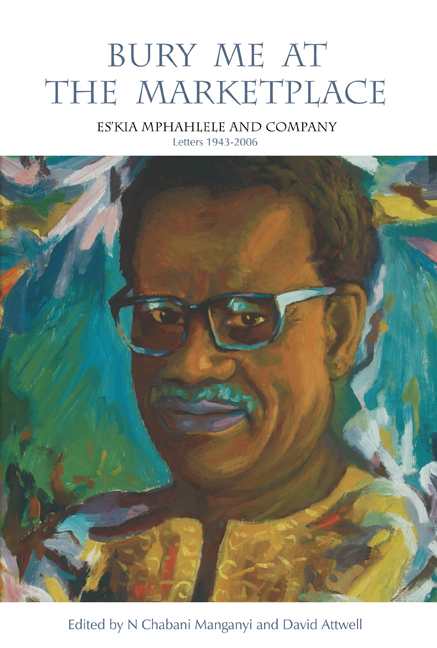Book contents
- Frontmatter
- Dedication
- Contents
- The Editors
- Acknowledgements
- Preface: In his Own Voice
- Introduction: Reading in the company of Es'kia Mphahlele
- Correspondents
- 1943
- 1944
- 1948
- 1952
- 1953
- 1954
- 1955
- 1957
- 1958
- 1959
- 1960
- 1961
- 1962
- 1963
- 1964
- 1965
- 1966
- 1967
- 1968
- 1969
- 1970
- 1971
- 1972
- 1973
- 1974
- 1975
- 1976
- 1977
- 1978
- 1979
- 1980
- 1981
- 1982
- 1983
- 1985
- 1987
- 1997
- 2000
- 2002
- 2005
- 2006
- Interviews: Looking In: In Search of Es'kia Mphahlele
- Metaphors of Self
- Interview References
- Index
Introduction: Reading in the company of Es'kia Mphahlele
Published online by Cambridge University Press: 04 June 2019
- Frontmatter
- Dedication
- Contents
- The Editors
- Acknowledgements
- Preface: In his Own Voice
- Introduction: Reading in the company of Es'kia Mphahlele
- Correspondents
- 1943
- 1944
- 1948
- 1952
- 1953
- 1954
- 1955
- 1957
- 1958
- 1959
- 1960
- 1961
- 1962
- 1963
- 1964
- 1965
- 1966
- 1967
- 1968
- 1969
- 1970
- 1971
- 1972
- 1973
- 1974
- 1975
- 1976
- 1977
- 1978
- 1979
- 1980
- 1981
- 1982
- 1983
- 1985
- 1987
- 1997
- 2000
- 2002
- 2005
- 2006
- Interviews: Looking In: In Search of Es'kia Mphahlele
- Metaphors of Self
- Interview References
- Index
Summary
Es'kia Mphahlele died on 28 October 2008, in his eighty-ninth year. His passing gives to this collection – and its title – a special, if poignant, relevance.
When Chabani Manganyi published the first edition of selected letters twenty-five years ago (1984) as a companion volume to Exiles and Homecomings: A Biography of Es'kia Mphahlele (1983), the idea of Mphahlele's death was remote and poetic. The title, Bury Me at the Marketplace, suggested that immortality of a kind awaited Mphahlele, in the very coming and going of those who remember him and whose lives he touched. It suggested, too, the energy and magnanimity of Mphahlele, the man, whose personality and intellect as a writer and educator would carve an indelible place for him in South Africa's public sphere.
That death has now come and we mourn it. Manganyi's words at the time have acquired a new significance: in the symbolic marketplace, he noted, ‘the drama of life continues relentlessly and the silence of death is unmasked for all time’. The silence of death is certainly unmasked in this volume, in its record of Mphahlele's rich and varied life: his private words, his passions and obsessions, his arguments, his loves, hopes, achievements, and yes, even some of his failures. Here the reader will find many facets of the private man translated back into the marketplace of public memory.
When the first edition was published Manganyi envisaged this expanded volume: ‘a promising enterprise for future scholarship would be a collection of letters from and to Es'kia Mphahlele of which there is already an extensive collection’, and ‘a later edition of this work will probably include many more letters than are included in this collection. The gaps are now well known and it will be the task of future research to plug them.’ In this second edition these hopes have largely been realised.
This selection of Mphahlele's own letters has indeed been greatly expanded; it has also been augmented by the addition of a large number of letters from Mphahlele's correspondents.
- Type
- Chapter
- Information
- Bury Me at the MarketplaceEs'kia Mphahlele and Company: Letters 1943-2006, pp. 6 - 16Publisher: Wits University PressPrint publication year: 2009

